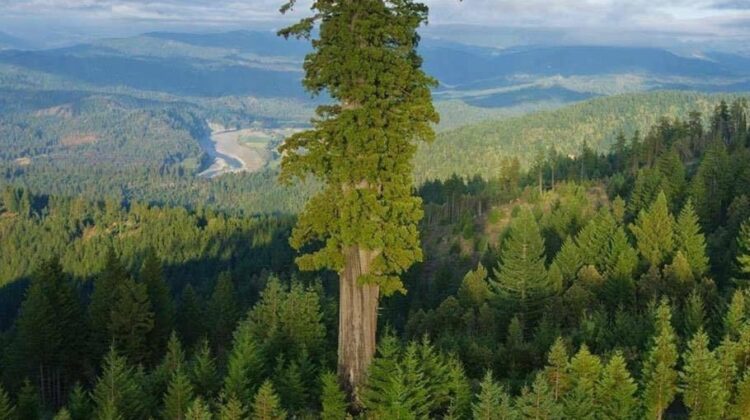
Sequoia sempervirens (/səˈkwɔɪ.əˌsɛmpərˈvaɪrənz/) is the sole living species of the genusSequoia in the cypress family Cupressaceae (formerly treated in Taxodiaceae). Common names include coast redwood, coastal redwood, and California redwood. It is an evergreen, long-lived, monoecious tree living 1,200–2,200 years or more. This species includes the tallest living trees on Earth, reaching up to 115.9 m (380.1 ft) in height (without the roots) and up to 8.9 m (29 ft) in diameter at breast height. These trees are also among the longest-living organisms on Earth. Before commercial logging and clearing began by the 1850s, this massive tree occurred naturally in an estimated 810,000 ha (2,000,000 acres) along much of coastal California (excluding southern California where rainfall is not sufficient) and the southwestern corner of coastal Oregon within the United States.
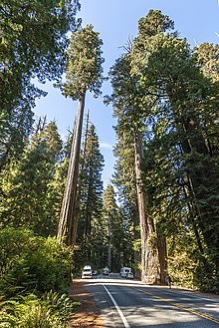
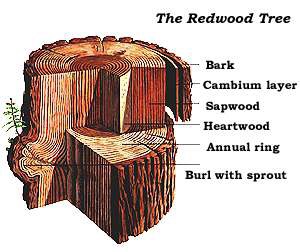
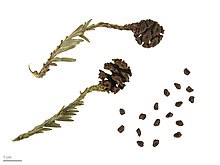
The name sequoia sometimes refers to the subfamily Sequoioideae, which includes S. sempervirens along with Sequoiadendron(giant sequoia) and Metasequoia (dawn redwood). Here, the term redwood on its own refers to the species covered in this article but not to the other two species.
Description
The coast redwood is known to have reached 115.5 m (379 ft) tall, with a trunk diameter of 9 m (30 ft). It has a conical crown, with horizontal to slightly drooping branches. The trunk is remarkably straight. The bark can be very thick, up to 30 cm (1 ft), and quite soft and fibrous, with a bright red-brown color when freshly exposed (hence the name redwood), weathering darker. The root system is composed of shallow, wide-spreading lateral roots.
The leaves are variable, being 15–25 mm (5⁄8–1 in) long and flat on young trees and shaded lower branches in older trees. The leaves are scalelike, 5–10 mm (1⁄4–3⁄8 in) long on shoots in full sun in the upper crown of older trees, with a full range of transition between the two extremes. They are dark green above and have two blue-white stomatal bands below. Leaf arrangement is spiral, but the larger shade leaves are twisted at the base to lie in a flat plane for maximum light capture.
The species is monoecious, with pollen and seed cones on the same plant. The seed conesare ovoid, 15–32 mm (9⁄16–1+1⁄4 in) long, with 15–25 spirally arranged scales; pollination is in late winter with maturation about 8–9 months after. Each cone scale bears three to seven seeds, each seed 3–4 mm (1⁄8–3⁄16 in) long and 0.5 mm (1⁄32 in) broad, with two wings 1 mm (1⁄16 in) wide. The seeds are released when the cone scales dry out and open at maturity. The pollen cones are ovular and 4–6 mm (3⁄16–1⁄4 in) long.
Its genetic makeup is unusual among conifers, being a hexaploid (6n) and possibly allopolyploid (AAAABB). Both the mitochondrial and chloroplast genomes of the redwood are paternally inherited.
Taxonomy
Scottish botanist David Don described the redwood as the evergreen taxodium (Taxodium sempervirens) in his colleague Aylmer Bourke Lambert‘s 1824 work A description of the genus Pinus. Austrian botanist Stephan Endlicher erected the genus Sequoia in his 1847 work Synopsis coniferarum, giving the redwood its current binomial name of Sequoia sempervirens. Endlicher probably derived the name Sequoia from the Cherokee name of George Gist, usually spelled Sequoyah, who developed the still-used Cherokee syllabary. The redwood is one of three living species, each in its own genus, in the subfamily Sequoioideae. Molecular studies have shown that the three are each other’s closest relatives, generally with the redwood and giant sequoia (Sequoiadendron giganteum) as each other’s closest relatives. However, Yang and colleagues in 2010 queried the polyploid state of the redwood and speculate that it may have arisen as an ancient hybrid between ancestors of the giant sequoia and dawn redwood (Metasequoia). Using two different single copy nuclear genes, LFY and NLY, to generate phylogenetic trees, they found that Sequoiawas clustered with Metasequoia in the tree generated using the LFY gene, but with Sequoiadendron in the tree generated with the NLY gene. Further analysis strongly supported the hypothesis that Sequoia was the result of a hybridization event involving Metasequoia and Sequoiadendron. Thus, Yang and colleagues hypothesize that the inconsistent relationships among Metasequoia, Sequoia, and Sequoiadendron could be a sign of reticulate evolution (in which two species hybridize and give rise to a third) among the three genera. However, the long evolutionary history of the three genera (the earliest fossil remains being from the Jurassic) make resolving the specifics of when and how Sequoia originated once and for all a difficult matter—especially since it in part depends on an incomplete fossil record.
Distribution and habitat
Coast redwoods occupy a narrow strip of land approximately 750 km (470 mi) in length and 8–75 km (5–47 mi) in width along the Pacific coast of North America; the most southerly grove is in Monterey County, California, and the most northerly groves are in extreme southwestern Oregon. The prevailing elevation range is 30–750 m (100–2,460 ft) above sea level, occasionally down to 0 and up to about 900 m (3,000 ft). They usually grow in the mountains where precipitation from the incoming moisture off the ocean is greater. The tallest and oldest trees are found in deep valleys and gullies, where year-round streams can flow, and fog drip is regular. The terrainalso made it harder for loggers to get to the trees and to get them out after felling. The trees above the fog layer, above about 700 m (2,300 ft), are shorter and smaller due to the drier, windier, and colder conditions. In addition, Douglas-fir, pine, and tanoak often crowd out redwoods at these elevations. Few redwoods grow close to the ocean, due to intense salt spray, sand, and wind. Coalescence of coastal fog accounts for a considerable part of the trees’ water needs.[18]Fog in the 21st century is, however, reduced from what it was in the prior century, which is a problem that may be compounded by climate change.
The northern boundary of its range is marked by two groves on mountain slopes along the north side of the Chetco River, which is on the western fringe of the Klamath Mountains, near the California-Oregon border. The northernmost grove is located within Alfred A. Loeb State Park and Siskiyou National Forest at the approximate coordinates 42°07’36″N 124°12’17″W. The southern boundary of its range is the Los Padres National Forest‘s Silver Peak Wilderness in the Santa Lucia Mountainsof the Big Sur area of Monterey County, California. The southernmost grove is in the Southern Redwood Botanical Area, just north of the national forest’s Salmon Creek trailhead and near the San Luis Obispo County line.[23][24]
The largest and tallest populations are in California’s Redwood National and State Parks(Del Norte and Humboldt counties) and Humboldt Redwoods State Park, with the overall majority located in the large Humboldt County.
The prehistoric fossil range of the genus is considerably greater, with a subcosmopolitan distribution including Europe and Asia until about 5 million years ago. During the last ice age, perhaps as recently as 10,000 years ago, redwood trees grew as far south as the Los Angeles area (coast redwood bark found in subway excavations and at La Brea Tar Pits).
Reproduction
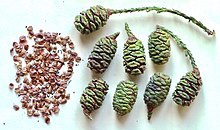
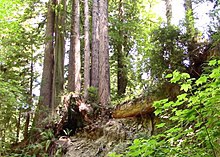
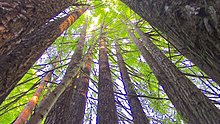
Coast redwood reproduces both sexually by seed and asexually by sprouting of buds, layering, or lignotubers. Seed production begins at 10–15 years of age. Cones develop in the winter and mature by fall. In the early stages, the cones look like flowers, and are commonly called “flowers” by professional foresters, although this is not strictly correct. Coast redwoods produce many cones, with redwoods in new forests producing thousands per year. The cones themselves hold 90–150 seeds, but viability of seed is low, typically well below 15% with one estimate of average rates being 3 to 10 percent. The low viability may discourage seed predators, which do not want to waste time sorting chaff (empty seeds) from edible seeds. Successful germination often requires a fire or flood, reducing competition for seedlings. The winged seeds are small and light, weighing 3.3–5.0 mg (200–300 seeds/g; 5,600–8,500/ounce). The wings are not effective for wide dispersal, and seeds are dispersed by wind an average of only 60–120 m (200–390 ft) from the parent tree. Seedlings are susceptible to fungal infection and predation by banana slugs, brush rabbits, and nematodes. Most seedlings do not survive their first three years. However, those that become established grow rapidly, with young trees known to reach 20 m (66 ft) tall in 20 years.
Coast redwoods can also reproduce asexually by layering or sprouting from the root crown, stump, or even fallen branches; if a tree falls over, it generates a row of new trees along the trunk, so many trees naturally grow in a straight line. Sprouts originate from dormant or adventitious buds at or under the surface of the bark. The dormant sprouts are stimulated when the main adult stem gets damaged or starts to die. Many sprouts spontaneously erupt and develop around the circumference of the tree trunk. Within a short period after sprouting, each sprout develops its own root system, with the dominant sprouts forming a ring of trees around the parent root crown or stump. This ring of trees is called a “fairy ring”. Sprouts can achieve heights of 2.3 m (7 ft 7 in) in a single growing season.
Redwoods may also reproduce using burls. A burl is a woody lignotuber that commonly appears on a redwood tree below the soil line, though usually within 3 m (10 ft) in depth from the soil surface. Coast redwoods develop burls as seedlings from the axils of their cotyledon, a trait that is extremely rare in conifers. When provoked by damage, dormant buds in the burls sprout new shoots and roots. Burls are also capable of sprouting into new trees when detached from the parent tree, though exactly how this happens is yet to be studied. Shoot clones commonly sprout from burls and are often turned into decorative hedges when found in suburbia.
Cultivation and uses
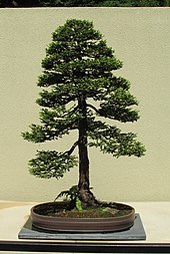
Coast redwood is one of the most valuable timber species in the lumbering industry. In California, 3,640 km2 (899,000 acres) of redwood forest are logged, virtually all of it second growth. Though many entities have existed in the cutting and management of redwoods, perhaps none has had a more storied role than the Pacific Lumber Company(1863–2008) of Humboldt County, California, where it owned and managed over 810 km2(200,000 acres) of forests, primarily redwood. Coast redwood lumber is highly valued for its beauty, light weight, and resistance to decay. Its lack of resin makes it absorb water and resist fire.
P.H. Shaughnessy, Chief Engineer of the San Francisco Fire Department wrote:
In the recent great fire of San Francisco, that began April 18th, 1906, we succeeded in finally stopping it in nearly all directions where the unburned buildings were almost entirely of frame construction, and if the exterior finish of these buildings had not been of redwood lumber, I am satisfied that the area of the burned district would have been greatly extended.
Because of its impressive resistance to decay, redwood was extensively used for railroad tiesand trestles throughout California. Many of the old ties have been recycled for use in gardens as borders, steps, house beams, etc. Redwood burls are used in the production of table tops, veneers, and turned goods.
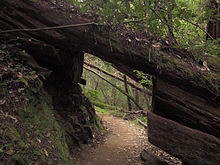
The Yurok people, who occupied the region before European settlement, regularly burned off ground cover in redwood forests to bolster tanoak populations from which they harvested acorns, to maintain forest openings, and to boost populations of useful plant species such as those for medicine or basketmaking.
Extensive logging of redwoods began in the early nineteenth century. The trees were felled by ax and saw onto beds of tree limbs and shrubs to cushion their fall. Stripped of their bark, the logs were transported to mills or waterways by oxen or horse. Loggers then burned the accumulated tree limbs, shrubs, and bark. The repeated fires favored secondary forests of primarily redwoods as redwood seedlings sprout readily in burned areas. The introduction of steam engines let crews drag logs through long skid trails to nearby railroads, furthering the reach of loggers beyond the land nearby rivers previously used to transport trees. This method of harvesting, however, disturbed large amounts of soil, producing secondary-growth forests of species other than redwood such as Douglas-fir, grand fir, and western hemlock. After World War II, trucks and tractors gradually replaced steam engines, giving rise to two harvesting approaches: clearcutting and selection harvesting. Clearcutting involved felling all the trees in a particular area. It was encouraged by tax laws that exempted all standing timber from taxation if 70% of trees in the area were harvested. Selection logging, by contrast, called for the removal 25% to 50% of mature trees in the hopes that the remaining trees would allow for future growth and reseeding. This method, however, encouraged growth of other tree species, converting redwood forests into mixed forests of redwood, grand fir, Sitka spruce, and western hemlock. Moreover, the trees left standing were often felled by windthrow; that is, they were often blown over by the wind.
The coast redwood is naturalized in New Zealand, notably at Whakarewarewa Forest, Rotorua. Redwood has been grown in New Zealand plantations for more than 100 years, and those planted in New Zealand have higher growth rates than those in California, mainly because of even rainfall distribution through the year. Other areas of successful cultivation outside of the native range include Great Britain, Italy, Portugal, Haida Gwaii, middle elevations of Hawaii, Hogsback in South Africa, the Knysna Afromontane forests in the Western Cape, Grootvadersbosch Forest Reserve near Swellendam, South Africa and the Tokai Arboretum on the slopes of Table Mountain above Cape Town, a small area in central Mexico (Jilotepec), and the southeastern United States from eastern Texas to Maryland. It also does well in the Pacific Northwest (Oregon, Washington, and British Columbia), far north of its northernmost native range in southwestern Oregon. Coast redwood trees were used in a display at Rockefeller Center and then given to Longhouse Reserve in East Hampton, Long Island, New York, and these have now been living there for over twenty years and have survived at 2 °F (−17 °C).
This fast-growing tree can be grown as an ornamental specimen in those large parks and gardens that can accommodate its massive size. It has gained the Royal Horticultural Society‘s Award of Garden Merit.
Statistics
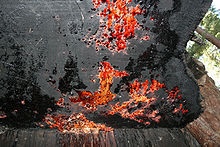
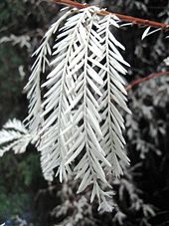
Fairly solid evidence indicates that coast redwoods were the world’s largest trees before logging, with numerous historical specimens reportedly over 122 m (400 ft). The theoretical maximum potential height of coast redwoods is thought to be limited to between 122 and 130 m (400 and 427 ft), as evapotranspiration is insufficient to transport water to leaves beyond this range. Further studies have indicated that this maximum requires fog, which is prevalent in these trees’ natural environment.
A tree reportedly 114.3 m (375 ft) in length was felled in Sonoma County by the Murphy Brothers saw mill in the 1870s, another claimed to be 115.8 m (380 ft) and 7.9 m (26 ft) in diameter was cut down near Eureka in 1914, and the Lindsey Creek tree was documented to have a height of 120 m (390 ft) when it was uprooted and felled by a storm in 1905. A tree reportedly 129.2 m (424 ft) tall was felled in November 1886 by the Elk River Mill and Lumber Co. in Humboldt County, yielding 79,736 marketable board feet from 21 cuts. In 1893, a Redwood cut at Eel River, near Scotia, reportedly measured 130.1 m (427 ft) in length, and 23.5 m (77 ft) in girth. However, limited evidence corroborates these historical measurements.
Today, trees over 60 m (200 ft) are common, and many are over 90 m (300 ft). The current tallest tree is the Hyperion tree, measuring 115.61 m (379.3 ft). The tree was discovered in Redwood National Park during mid-2006 by Chris Atkins and Michael Taylor, and is thought to be the world’s tallest living organism. The previous record holder was the Stratosphere Giant in Humboldt Redwoods State Park at 112.84 m (370.2 ft) (as measured in 2004). Until it fell in March 1991, the “Dyerville Giant” was the record holder. It, too, stood in Humboldt Redwoods State Park and was 113.4 m (372 ft) high and estimated to be 1,600 years old. This fallen giant has been preserved in the park.
As of 2016, no living specimen of other tree species exceeds 100 m (330 ft). The largest known living coast redwood is Grogan’s Fault, discovered in 2014 by Chris Atkins and Mario Vaden in Redwood National Park, with a main trunk volume of at least 1,084.5 cubic meters (38,299 cu ft) Other high-volume coast redwoods include Iluvatar, with a main trunk volume of 1,033 m3 (36,470 cu ft),: 160and the Lost Monarch, with a main trunk volume of 988.7 m3 (34,914 cu ft).
Albino redwoods are mutants that cannot manufacture chlorophyll. About 230 examples (including growths and sprouts) are known to exist, reaching heights of up to 20 m (66 ft). These trees survive like parasites, obtaining food from green parent trees. While similar mutations occur sporadically in other conifers, no cases are known of such individuals surviving to maturity in any other conifer species. Recent research news reports that albino redwoods can store higher concentrations of toxic metals, going so far as comparing them to organs or “waste dumps”.

Leave a Reply